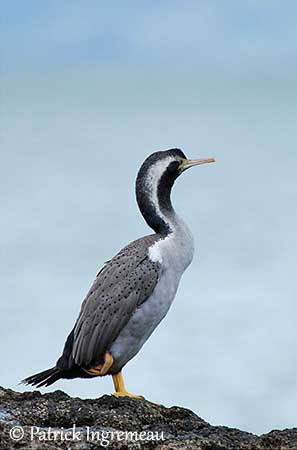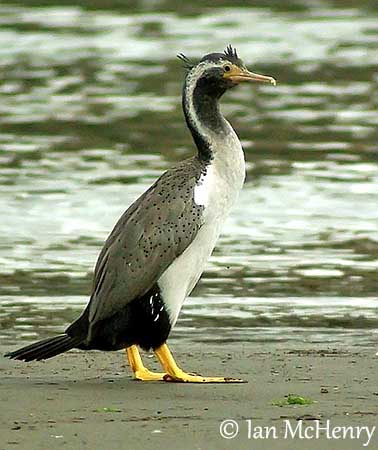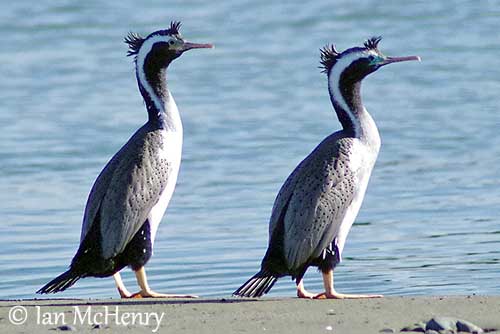
Fr: Cormoran moucheté
Ang: Spotted Shag
Maori: Parekareka
All: Tüpfelscharbe
Esp: Cormorán Moteado
Ita: Cormorano macchiato
Nd: Gevlekte Aalscholver
Sd: Fläckskarv
Photographers:
Patrick Ingremeau
TAMANDUA
Ian McHenry
My New Zealand Birds
Text by Nicole Bouglouan
Sources :
HANDBOOK OF THE BIRDS OF THE WORLD vol 1 by Josep del Hoyo-Andrew Elliot-Jordi Sargatal - Lynx Edicions - ISBN: 8487334105
KNOW YOUR NEW ZEALAND BIRDS by Lynnette Moon - New Holland Publishers – ISBN: 1869660897
BirdLife International (BirdLife International)
New Zealand bird status between 2008 and 2012
New Zealand birds and birding (Narena Olliver)
Te Ara – The Encyclopedia of New Zealand
Tiritiri Matangi Open Sanctuary
Page family Phalacrocoracidae
Summary cards
Spotted Shag
Phalacrocorax punctatus
Suliformes Order – Phalacrocoracidae Family
INTRODUCTION:
The Spotted Shag is endemic to New Zealand and is probably the most elegant and beautiful shag of this region. It feeds at sea and breeds in colonies on coastal rocky cliffs.
It is sometimes included on the genus “Spictocarbo” along with the Pitt Island Shag. Both are yellow-footed shag species endemic to New Zealand. Its Maori name is “Parekareka”.
DESCRIPTION OF THE BIRD:
Biometrics:
Length: 64-74 cm
Weight: 700-1200 g
The adult in breeding plumage has silver grey and brown back and wings, finely spotted black. This spotted pattern is formed by the black-tipped feathers except the flight feathers. Mantle, scapulars and wings show olive-brown to bronze-brown gloss. Back to uppertail-coverts is black with deep blue gloss. The underparts are pale blue-grey. Thighs, vent, rump and tail are black. The underwing is dull brownish.
We can see a broad white stripe from above the eye, extending down to the sides of neck and breast. The feathers are black on head sides to cheek and upper foreneck, and fade into grey on lower foreneck to belly.

The breeding adult has two conspicuous black upcurved crests, one on the forecrown and other on the nape. Crown and nape are glossy blue. There are scattered white filoplumes, usually longer and thicker on thighs, rump and mainly hindneck.
However, they are rapidly lost after pairing, and the crests also reduce or disappear through the nesting period.
On the head, the bare facial skin becomes blue-green before the breeding season. The long, slender bill is orange-brown. The eyes are dark brown, surrounded by blue eyering. Legs and webbed feet are yellow-orange.
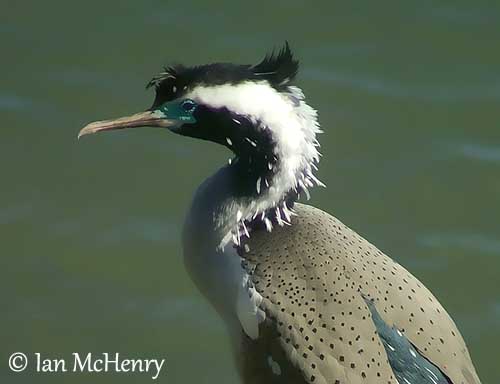
Male and female are similar. They are duller in non-breeding plumage. They lack the two crests and the white filoplumes. The neck stripe shows dark feathers and appears darker. The facial skin becomes yellowish. The underparts are paler too.
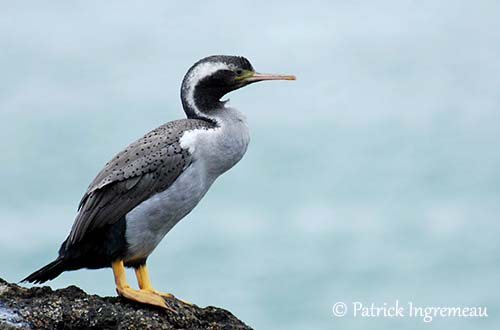
The immature is browner and paler than adults. Head and neck patterns are lacking.
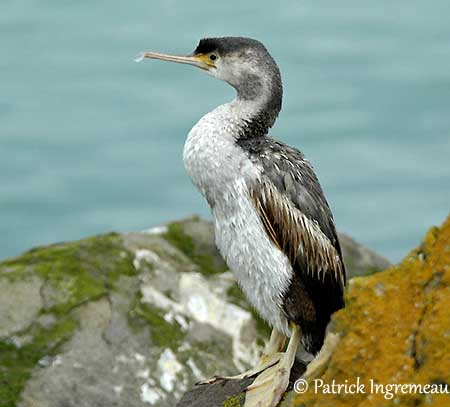
SUBSPECIES AND RANGE:
The Spotted Shag has two subspecies.
P.p. punctatus (here described and displayed) is found in New Zealand. It breeds on the coasts of North Island, and N and E South Island.
P.p. oliveri occurs on Stewart Island and in Westland on South Island. This race is darker than nominate, with narrower white stripe on head and neck sides. The lower upperparts show mostly greenish-blue gloss.
HABITAT:
The Spotted Shag frequents the coastal waters out to 16 kilometres, inlets and estuaries where it feeds and roosts in flocks.
They breed on rocky cliffs along the coasts or inshore islands. This species does not frequent inland fresh waters.
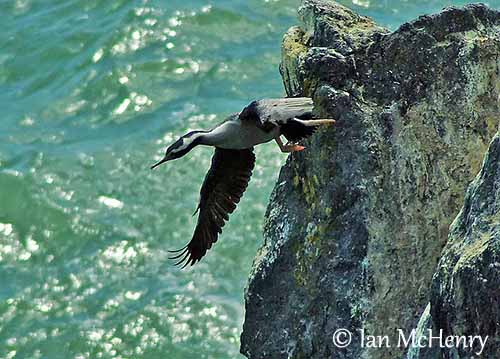
CALLS AND SONGS: SOUNDS BY XENO-CANTO
The Spotted Shag usually produces loud grunts at nesting sites, nightime roosts and when resting in flocks. It is silent outside these areas.
They utter “smack-smack-smack” sounds when the fly low over the water in long lines after feeding.
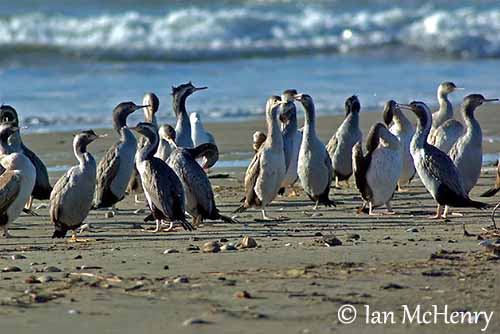
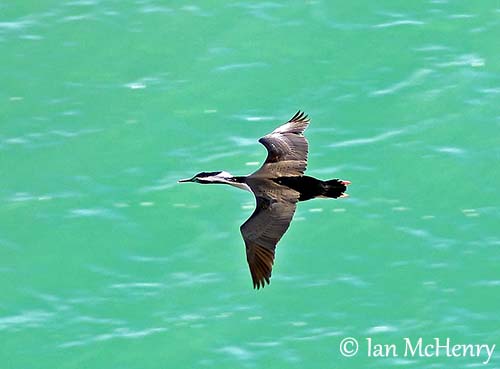
BEHAVIOUR IN THE WILD:
The Spotted Shag feeds on small fish and marine invertebrates, squid and plankton. It hunts at sea in deep water, but also in estuaries, bays, inlets and occasionally in harbours.
It dives from the surface, propelling itself with the webbed feet. It is an expert diver and may remain underwater for 30 seconds or more. Once the prey is caught, it brings it to the surface and swallows it.
After fishing, it perches on rocks and dries the wings by spreading them widely.
It often swallows small stones which are regurgitated at roosting sites. The function of these stones is still debated. They could be used as ballast or to grind up the food.
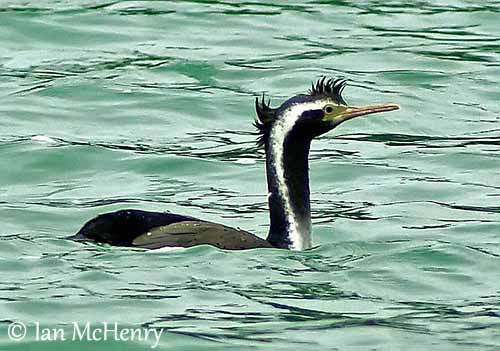
During the breeding season, the Spotted Shag develops a breeding plumage with two crests and a profusion of scattered silky white filoplumes. The male displays to attract a mate. The crests are spread and the bird flaps its wings while rapidly vibrating, moving the head up and down. The male often displays noisily, whereas the female is silent. They are monogamous.
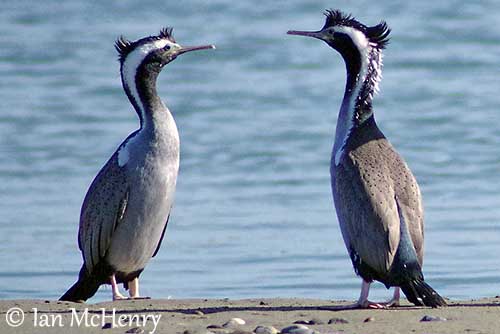
The Spotted Shag only performs local movements along the coasts in winter. This species forms large feeding and roosting flocks of up to 2000 individuals.
With its fairly short, rounded wings, the shag performs fast, powerful wingbeats. It flies near the sea surface to save the energy.

REPRODUCTION OF THIS SPECIES:
The breeding season varies according to the range, but depends mainly on food resources. They breed in colonies of some pairs to 700 pairs, and some of these colonies are very dense like the colony of Banks Peninsula, and others have more scattered nests like the colony of Marlborough Sounds. These colonies are established on vertical sea cliffs, often on rocky ledges.
The nest is made with seaweeds and sometimes floating debris, but the nearby plants such as grass and tussock can be used too. This is a simple platform placed on to ledge.
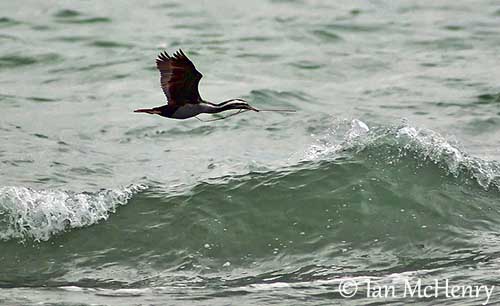
The female lays 3-4 pale blue eggs and both parents incubate during 28-35 days. The chicks are guarded, and both parents feed them about four times a day. They are naked at hatching, but they are quickly covered with grey down. They fledge about 57-70 days after hatching, usually at 62-63 days of age. They are sexually mature at two years.
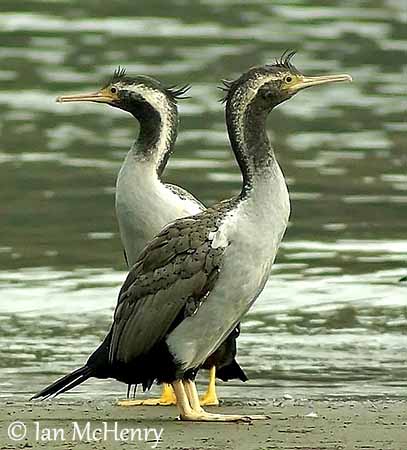
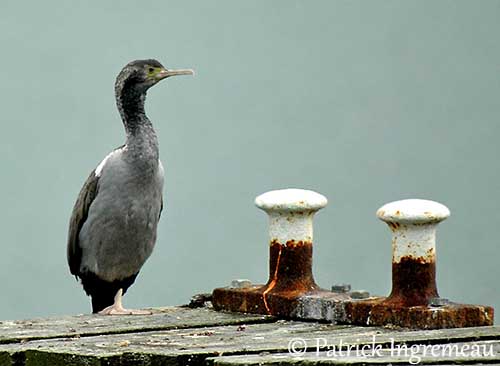
PROTECTION / THREATS / STATUS:
The Spotted Shag is now a fully protected species after suffering much persecution such as shooting and destruction of colonies in the 1970s, involving local declines. They are affected by disturbances at recreational sites, and some birds are accidentally caught and drown in fishing nets.
Currently, the Spotted Shag is evaluated as Least Concern.
